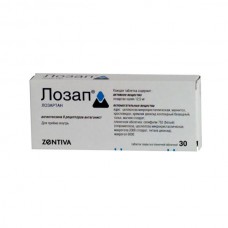Expiration date: 06/2026
Composition
1 tablet, film-coated, contains: 12.5, 50 or 100 mg of losartan potassium
Excipients: microcrystalline cellulose, mannitol, croscarmellose sodium, colloidal anhydrous silica, talc, magnesium stearate
The film wrapper: sepifilm 752 (White) (Valium, cellulose mikrokristalicheskaya, macrogol stearate 2000, titanium hydroxide), macrogol 6000
Packaging
The blister pack of 10 tablets. The cardboard packaging blister 3, 6 or 9.
Pharmachologic effect
Lozap - losartan is a specific antagonist of the angiotensin II receptor (AT 1 subtype). He inhibits kinase II - an enzyme that catalyzes a reaction for conversion of angiotensin I to angiotensin II.
It reduces peripheral vascular resistance, blood levels of adrenaline and aldosterone blood pressure, the pressure in the pulmonary circulation, reduces afterload, has a diuretic effect. It prevents the development of myocardial hypertrophy, increases exercise tolerance in heart failure patients.
Losartan inhibits the angiotensin converting enzyme (ACE) -kininazu and II, respectively, does not prevent the destruction of bradykinin, so side effects associated with the bradykinin-mediated (e.g., angioneurotic edema) occur infrequently.
After a single oral hypotensive effect (reduced systolic and diastolic blood pressure) reaches a maximum at six hours, then for 24 hours gradually reduced.
The maximum antihypertensive effect develops through Z-b weeks after starting the drug.
In patients with hypertension without concomitant diabetes mellitus with proteinuria (greater than 2 g / day), use of the drug significantly reduces proteinuria, urinary albumin and immunoglobulin G.
It stabilizes the level of urea in the blood plasma. No effect on autonomic reflexes and has no effect on long norepinephrine concentration in blood plasma. Losartan to 150 mg per day did not affect the level of triglycerides, total cholesterol and high density lipoprotein (HDL) in the serum of patients with arterial hypertension. At the same dose, losartan does not affect the blood glucose level on an empty stomach.
Testimony
- Arterial hypertension.
- Chronic heart failure (in a combination therapy, in case of intolerance or failure of therapy with ACE inhibitors).
- To reduce the risk of cardiovascular disease (including stroke) and mortality in patients with hypertension and left ventricular hypertrophy.
- Diabetic nephropathy with hypercreatininemia and proteinuria (urinary albumin ratio and creatinine of more than 300 mg / d) in patients with type 2 diabetes and concomitant hypertension (reduction in the progression of diabetic nephropathy to terminal chronic renal failure).
Contraindications
- Hypersensitivity to the drug.
- Pregnancy.
- Lactation.
- Age 18 years (effectiveness and safety have been established).
Carefully:
- Hypotension.
- Reduced blood volume.
- Violations of the water and electrolyte balance.
- Bilateral renal artery stenosis.
- Stenosis of the artery only kidney.
- Kidney failure.
- Liver failure.
Pregnancy and breast-feeding
Data for use during pregnancy Lozap not. However, it is known that drugs act directly on the renin-angiotensin system, when used in the II and III trimester of pregnancy may cause a defect in development, or even death of the developing fetus. Therefore, in the event of pregnancy Lozap reception should be stopped immediately.
In the appointment during lactation should decide or termination of breastfeeding, or termination of drug treatment.
Dosing and Administration
The drug is taken orally, regardless of food intake. Multiplicity of reception - 1 times per day.
When hypertension the average daily dose is 50 mg. In some cases, to achieve greater therapeutic effect, the dose was increased to 100 mg in one or two doses per day.
In heart failure, the initial dose for patients is 12.5 mg 1 time / day. Typically, the dose is increased at weekly intervals (i.e., 12.5 mg / day, 25 mg / day, 50 mg / day) to an average maintenance dose of 50 mg 1 time / day, depending on patient tolerability of the drug.
Patients receiving high doses of diuretics initial dose should be reduced to 1 to 25 mg once / day. No need to adjust the dose in elderly patients.
To reduce the risk of cardiovascular disease (including stroke) and mortality in patients with hypertension and left ventricular hypertrophy initial dose is 50 mg once a day. Further hydrochlorothiazide may be added in low doses and / or dose increased to 100 mg per day in one or two steps. Patients with concomitant type 2 diabetes mellitus with proteinuria: the drug is administered in an initial dose of 50 mg 1 time per day to further increase the dose to 100 mg / day (according to the degree of blood pressure lowering) in one or two steps.
In type 2 diabetes mellitus with proteinuria initial dose is 50 mg 1 time per day to further increase the dose to 100 mg / day (according to the degree of blood pressure lowering) in 1 or 2 divided doses.
Patients with a history of liver disease, dehydration, during hemodialysis and in patients older than 75 years should lower initial dose - 25 mg 1 time per day.
Side effects
Marked (*) side effects, the incidence of which is comparable to placebo.
Communication of side effects occurring with a frequency of less than 1% of cases, has not been proved with the use of losartan.
In most cases, Lozap well tolerated, side effects are transient in nature and do not require discontinuation of therapy.
From the nervous system and sensory organs: 1% or more - dizziness, asthenia, fatigue, headache, insomnia, less than 1% - anxiety, sleep disturbance, drowsiness, memory disorder, peripheral neuropathy, paresthesia, hypoesthesia, migraine, tremor, ataxia , depression, syncope, tinnitus, taste disturbance, changes in vision, conjunctivitis.
The respiratory system: 1% or more - nasal congestion, cough, upper respiratory tract infection (fever, sore throat, sinusopatiya *, sinusitis, pharyngitis), less than 1% - dyspnea, bronchitis, rhinitis.
From the digestive tract: 1% or more - nausea, diarrhea, dyspepsia, abdominal pain, less than 1% - anorexia, dry mouth, toothache, vomiting, flatulence, gastritis, constipation.
From the musculoskeletal system: 1% or more - cramps, myalgia *, back pain, chest, legs, less than 1% - arthralgia, pain in the shoulder, knee, arthritis, fibromyalgia.
Since the cardiovascular system: orthostatic hypotension (dose-dependent), palpitations, tachy or bradycardia, arrhythmia, angina, anemia.
With the genitourinary system: less than 1% - urgent need to urinate, urinary tract infection, renal failure, weakening of libido, impotence.
For the skin: less than 1% - dry skin, erythema, flushing, photosensitivity, increased sweating, alopecia.
Allergic reaction: less than 1% - urticaria, rash, pruritus, angioedema, including face, lips, pharynx and / or language.
Other: hyperkalemia (serum potassium> ,, 5.5 mmol / l).
Special instructions
It is necessary to carry out the correction of dehydration Lozap to the destination or start the treatment with the drug at a lower dose.
Drugs that affect the renin-angiotensin system may increase blood urea level and serum creatinine in patients with bilateral renal artery stenosis or stenosis of a solitary kidney.
During treatment should regularly monitor the concentration of potassium in the blood, especially in elderly patients with renal impairment.
Patients with cirrhosis losartan concentration in plasma is significantly increased, and therefore the presence of a history of liver disease should be administered in lower doses.
Losartan has no effect on the ability to drive or operate machinery.
Drug interactions
It may be administered with other antihypertensive agents. Synergistic effect of beta-blockers and sympatholytic. The combined use of losartan with a diuretic has an additive effect.
There was no pharmacokinetic interaction of losartan with hydrochlorothiazide, digoxin, warfarin, cimetidine, phenobarbital, ketoconazole and erythromycin. According to fluconazole and rifampicin reduce the level of the active metabolite in the blood plasma. The clinical significance of these interactions is unknown. As with other agents that inhibit angiotensin II or its effects, the combined use of losartan potassium-sparing diuretics (e.g., spironolactone, triamterene, amiloride), potassium salts and formulations containing potassium, increases the risk of hyperkalemia.
Nonsteroidal anti-inflammatory drugs (NSAIDs), including selective cyclooxygenase-2 (TS0G-2), can reduce the effect of diuretics or other antihypertensives.
In a joint application of angiotensin II receptor antagonists and lithium may increase the concentration of lithium in blood plasma. Given this, it is necessary to weigh the benefits and risks of combined use of losartan with lithium salts. If necessary to use in conjunction preparations, it is necessary regularly to monitor the concentration of lithium in the blood plasma.
Overdose
Symptoms: marked reduction of blood pressure, tachycardia, due to parasympathetic (vagal) stimulation may occur bradycardia.
Treatment: forced diuresis, symptomatic therapy, hemodialysis is not effective.
Storage conditions
Store at temperatures not above 30 ° C.
Shelf life
2 years.
Lozap
(Losartan)
- Brand: Zentiva






